Archive for the 'Board Game Review' Category
Posted by James (admin) on 2nd June 2014
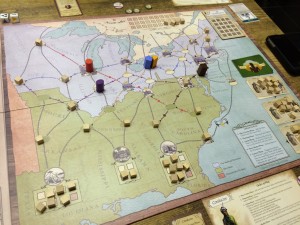
Freedom: The Underground Railroad is a co-operative game of freeing slaves in 19th Century America. The board shows the Eastern United States with routes between cities. Slaves (represented by cubes) start in the 3 plantation areas in the South and players try to move them across the States to freedom in Canada. There are also 5 different coloured/shaped slave catchers on the board who move along their own paths (primarily running East-West) throughout the game.
The goal is to get enough slaves to Canada before the game ends after a fixed number of rounds; however, players can only win if they also get enough support for the abolitionist movement (by buying every support counter), plus the game immediately ends in failure if too many slaves are lost. The numbers of freed slaves required, support tokens, tokens that move slaves and generate income, and maximum lost slaves are all based on the number of players and the difficulty level (normal or hard). Read the rest of this entry »
Tags: Academy Games, board game news, Board Games, board gaming, Freedom, Spiel 13, Spiel 2013
Posted in Board Game Review, Board Games, Essen Spiel 13, Freedom, Spiel 2013 | No Comments »
Posted by James (admin) on 1st June 2014
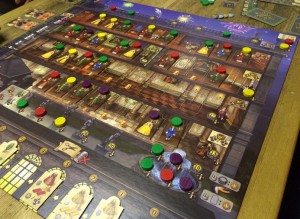 Rokoko is a euro-game about preparing for the ball at the Royal Palace. This may sound pretty light-weight but, do not be fooled, this is a euro-game with a lot of moving parts to work out, balance and combine – so it’s a game for gamers. It’s one of the games nominated for Spiel des Jahres Kennerspiel 2014 (the German complex game of the year).
Rokoko is a euro-game about preparing for the ball at the Royal Palace. This may sound pretty light-weight but, do not be fooled, this is a euro-game with a lot of moving parts to work out, balance and combine – so it’s a game for gamers. It’s one of the games nominated for Spiel des Jahres Kennerspiel 2014 (the German complex game of the year).
Players are aiming to earn the most Prestige Points (PPs) by the end of the game which is 7 rounds long when the ball takes place. Players each have cards which represent their tailors and, at the start of each round, players select 3 of their available tailors to use during that round. Players then take turns using one tailor to perform 1 action and they can also carry out any bonus shown on the tailor’s card too. Tailors are either apprentices, journeymen, or masters and some actions can not be performed by the less experienced tailors, i.e. only journeymen and masters can make dresses, and only masters can hire new tailors. Read the rest of this entry »
Tags: board game news, Board Games, board gaming, Eggertspiele, Essen, Pegasus Spiele, Rococo, Rokoko, SdJ, Spiel 13, Spiel 2013, Spiel des Jahres
Posted in Board Game Review, Board Games, Essen Spiel 13, Rokoko, Spiel 2013 | No Comments »
Posted by James (admin) on 28th May 2014
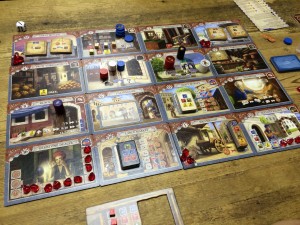
At the bottom of the photo, you can see a player’s hand cart which has yet to be upgraded. When it is, the upgrade tile fills-up part of the missing piece.
Istanbul is one of the games nominated for Spiel des Jahres Kennerspiel 2014 (the German complex game of the year) and is designed by Rüdiger Dorn who has designed a wealth of games. The game is a race to be the first to collect 5 gems with an interesting core game mechanic and a surprisingly dense amount of decision-making.
The board is made up of a 4×4 grid of locations (large tiles) and each player starts with a stack of wooden discs which are their merchant and assistants (with the merchant always on top). Players take turns moving their merchant (and any assistants currently underneath it) so they can use the actions of the location tiles. When a player moves to a location that does not contain one of their assistants, they remove an assistant from their stack, place it on the location, and then take the location’s action. When a player moves to a location that does contain one of their assistants, they add it to the bottom of the stack, and then take the location’s action. If a merchant moves on his own (without assistants) and lands on a location without assistants, then he can not take the location’s action.
So, players already need to work out which locations to visit, in what order, and how to do this by dropping off and picking up assistants along the way. The actions at each location are varied allowing players to gain goods (which come in 4 colours), gain money, buy gems, upgrade their cart, gain special abilities, gain special cards, etc. One location allows the player to gather up any assistants that are elsewhere on the board and place them under their merchant. Read the rest of this entry »
Tags: board game news, Board Games, board gaming, Istanbul, Pegasus Spiele, Rüdiger Dorn, SdJ, Spiel des Jahres
Posted in Board Game Review, Board Games, Istanbul | No Comments »
Posted by James (admin) on 23rd May 2014
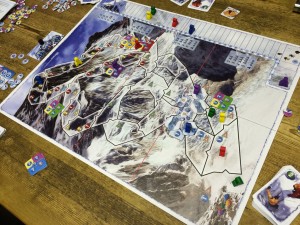 Mount Everest is a game by the designer of K2 which is a great game and you can read my review of K2 for more details. (This review assumes you have not played K2 and I will talk about comparisons at the very end.)
Mount Everest is a game by the designer of K2 which is a great game and you can read my review of K2 for more details. (This review assumes you have not played K2 and I will talk about comparisons at the very end.)
Players each have 2 guides who can escort clients (climbers and tourists) up and down the mountain. Players score Victory Points (VPs) for getting clients to the summit, and more VPs for getting those clients who have reached the summit safely back to base camp. Tourists are worth more VPs but are less hardy than climbers. Your guides can carry tents and oxygen too which are both very useful (in fact, they’re almost vital).
Each guide has a small board showing what they have with them (equipment and clients) but there is very limited space; for example, a guide can take 4 clients and no equipment, or 1 tent and 1 client, or 1 oxygen and 2 clients, etc. So, right from the start, you need to have a strategy on what to take and how to split it between your guides. Read the rest of this entry »
Tags: board game news, Board Games, board gaming, Essen, K2, Mount Everest, Rebel.pl, Spiel 13, Spiel 2013
Posted in Board Game Review, Board Games, Essen Spiel 13, Mount Everest, Spiel 2013 | No Comments »
Posted by James (admin) on 22nd May 2014
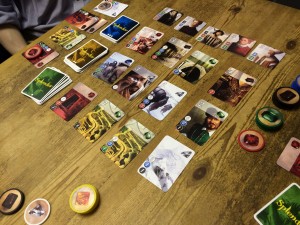 Splendor is a light, fast game of constant, small decisions. Overall, it’s a race to be the first player to score 15 Victory Points (VPs) by buying development cards using the 5 different coloured currencies (gems).
Splendor is a light, fast game of constant, small decisions. Overall, it’s a race to be the first player to score 15 Victory Points (VPs) by buying development cards using the 5 different coloured currencies (gems).
Each development card is a colour and each card shows its cost as well as how many VPs it is worth. Each card you purchase gives a permanent reduction on your future purchases; for example, a card costing 2 red gems and 3 green gems would only cost 2 red and 1 green if a player had already bought 2 green cards. As a result, players’ purchasing power increases as the game unfolds.
The game mechanic of discounting future purchases means that every card you buy is potentially useful and means each player has a slightly different view of the game because the costs of the cards on display become different for each player. Also, whilst gaining VPs is slow to start, with as players purchase the cheap (bottom row) cards usually worth no VPs, the game accelerates as players’ purchasing power increases and they can more regularly buy the expensive (top row) cards worth higher amounts of VPs. (Players can also score VPs by gaining noble tiles which are awarded as soon as a player has bought enough different coloured cards as shown on the tiles.) Read the rest of this entry »
Tags: board game news, Board Games, board gaming, SdJ, Space Cowboys, Spiel des Jahres, Splendor
Posted in Board Game Review, Board Games, Splendor | No Comments »
Posted by James (admin) on 20th May 2014
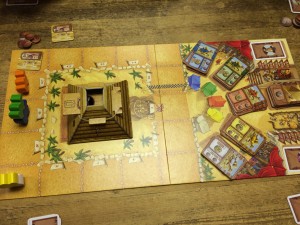 Camel Up is a simple game so it is surprising how much interaction there is and how lively it can be. During the game, camels move around a simple circuit; however, players do not own a specific camel as you may expect. Instead, players take actions which can move the camels as well as try to predict which camel will win the current round, as well as the overall race. The winner is the player with the most money (Egyptian Pounds, or EPs) at the end of the game.
Camel Up is a simple game so it is surprising how much interaction there is and how lively it can be. During the game, camels move around a simple circuit; however, players do not own a specific camel as you may expect. Instead, players take actions which can move the camels as well as try to predict which camel will win the current round, as well as the overall race. The winner is the player with the most money (Egyptian Pounds, or EPs) at the end of the game.
Players take turns by performing one of 4 actions which are:
1. Move a camel
The player drops 1 dice out of the pyramid and moves the matching coloured camel that number of spaces forwards along the track. (There are 5 dice – one for each camel each with values 1 to 3 – more about the pyramid later.) If camels are moved to space occupied by camels they are stacked on top of those already there. When camels move, they carry any other camels already on top of them along with them too. This action earns the player 1 EP. (The dice only get placed back in the pyramid after all 5 have come out which and this ends the round.)
2. Place/Move their desert tile on the race track
This tile earns 1 EP for its owner each time a camel lands on it, plus it moves that camel forwards 1 space if the tile is oasis side-up, or backwards 1 space if the tile is mirage side-up. Read the rest of this entry »
Tags: board game news, Board Games, board gaming, Camel Up, Eggertspiele, Pegasus Spiele, SdJ, Spiel des Jahres
Posted in Board Game Review, Board Games, Camel Up | 2 Comments »
Posted by James (admin) on 17th April 2014
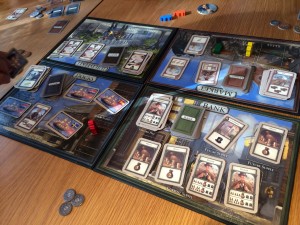 One of my favourite board games ever is Oregon (which was the game the designers of Rattus made before Rattus). So, after many Rattus expansions, I was very excited when the Bergs announced a new, original game called Packet Row with a very interesting game mechanic.
One of my favourite board games ever is Oregon (which was the game the designers of Rattus made before Rattus). So, after many Rattus expansions, I was very excited when the Bergs announced a new, original game called Packet Row with a very interesting game mechanic.
The game is set in New York in 1842 and players are trading companies. The game board is comprised of 4 boards (Docks, Bank, Market and Guildhall) where the cards for each board are displayed. The primary method of earning money is by completing contracts (Guildhall cards) which can be fulfilled by having the goods (Market cards) and ship (Dock cards) shown on the contract. Money can also be gained from the bank (Bank cards), plus various other cards in all areas have some special effects too including some being worth victory points (VPs). At the end of the game, players add up their VPs from cards that show VPs, cash (divided by 10), and banker cards (if they have the most cash) – most VPs wins. This means cash is vital because most cards cost money, and cards can earn you more money, VPs and special abilities.
Gameplay is simple and fast as each player may gain up to 1 card during a round. So far this is all straight forwards but it is how the cards are gained that is the interesting heart of Packet Row. Each round, one player is the lead player (the harbour master) and they select one of the 4 boards. All players then take turns choosing to either take one of the cards from this board or pass. The harbour master is the last player to choose – if the harbor master takes a card then the round ends and any player(s) who passed get nothing. If the harbour master doesn’t take a card, then the harbour master chooses another board and all players who have not yet taken a card this round have the same choice again – take a card from this board or pass. Read the rest of this entry »
Tags: board game news, Board Games, board gaming, Essen, Oregon, Packet Row, Rattus, Spiel 13, Spiel 2013, White Goblin Games
Posted in Board Game Review, Board Games, Essen Spiel 13, Packet Row, Spiel 2013 | No Comments »
Posted by James (admin) on 16th April 2014
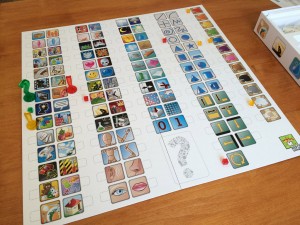
My attempt at ‘Wheel of Fortune’ using TV show with ideas as the main concept. Then, adding a sub-concept of Title with circle, rotate & cash. Then, adding a sub-concept of Country with Red, White, Blue & Star. Anyone? Anyone? Bueller?
Concept is a party game that is a bit like charades without the acting and players use a board with icons to convey the various concepts so the other players can guess the correct answer. Each turn, the players whose turn it is draw a card and choose which word/expression they will try to convey by placing coloured markers on the different descriptive icons on the board. Player aid sheets show all the icons with 2 or 3 things that each icon could mean (although players can use them to mean anything they want). Icons show things like colours, shapes, parts of the body, etc. and some have broader potential meaning like a figure with a walking stick can mean Old/Ancient/Past.
To convey a word/phrase, the current players place various markers on these icons. There is one green question mark marker with green cubes (which is used to describe the main concept) and 4 different colour exclamation mark markers with matching coloured cubes (which can be used to describe additional sub-concepts).
For example, to convey ‘Eiffel Tower’ a player could place the green question mark on ‘Object/Thing/Package’ and a green cube on ‘Tall/Greater/High’ to try to convey the main concept is a tall object. Then, they place a red exclamation mark on ‘Location/Country/Flag’ and red cubes on ‘Red’, ‘White’, and ‘Blue’ to convey the sub-concept is a country with a red, white and blue flag. Already the description is taking shape, although players may guess it’s The Shard in London, or the World Trade Centre in New York from the same markers. Read the rest of this entry »
Tags: board game news, Board Games, board gaming, Concept, Essen, Repos Productions, Spiel 13, Spiel 2013
Posted in Board Game Review, Board Games, Concept, Essen Spiel 13, Spiel 2013 | No Comments »
Posted by James (admin) on 15th April 2014
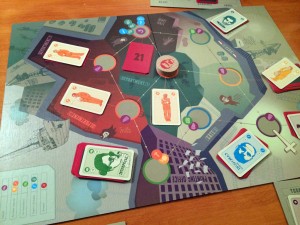 Strike is a game about Lech Wałęsa – a Polish electrician who became a trade-union activist, co-founded Solidarity (the Soviet bloc’s first independent trade union) and eventually went on to become President of Poland. The game focuses on the Polish strikes of 1980 and the agreement reached between the workers and the government. (Yes, really.)
Strike is a game about Lech Wałęsa – a Polish electrician who became a trade-union activist, co-founded Solidarity (the Soviet bloc’s first independent trade union) and eventually went on to become President of Poland. The game focuses on the Polish strikes of 1980 and the agreement reached between the workers and the government. (Yes, really.)
This theme may sound unusual even compared to some other board games, but the historical Polish theme is more understandable when you know the game is by Karol Madaj the designer of Kolejka (Queue) – one of my favourite games ever – who designs games for Poland’s Institute of National Remembrance. One of their goals is to mark important moments in Polish history.
Theme-aside, Strajk is fundamentally a deck-building game mechanic but with a board and a bit if a difference too. (If you’re not familiar with deck-building games such as Dominion, players each have their own deck and play cards to add better cards to their deck, take special actions, remove weaker cards from their deck, etc. Whenever their deck is empty, they shuffle their discard pile and start drawing from it again so their deck builds as they play.) Read the rest of this entry »
Tags: board game news, Board Games, board gaming, Essen, Kolejka, Queue, Reglamentacja, Spiel 13, Spiel 2013, Strajk, Strike
Posted in Board Game Review, Board Games, Essen Spiel 13, Kolejka (Queue), Reglamentacja, Spiel 2013, Strajk (Strike) | No Comments »
Posted by James (admin) on 14th April 2014
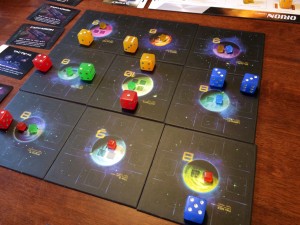
Quantum is a light, space-themed game. Players have ships which are represented by dice that travel between the planets trying to colonise them (place cubes on them). The first player to place all their cubes wins.
The ships (dice) are rolled to determine what type of ship they are – a low number means they are slow moving but powerful in combat, and vice versa. (In fact, the dice value is how many spaces they can move which makes things simple.) Each type of ship has a special power too, such as transporting another ship, swapping places, changing a ship’s value and this makes each quite different.
On their turn, a player can take 3 actions. An action can be used to activate a ship (move/attack), re-roll a ship, bring a ship on from the scrap yard, or carry out research. A player can use 2 actions to place a cube on a planet if they have ships next to the planet that add up to the planet’s number and if there is still room to place a cube there. (A player can also place a cube if they win enough combats.) Read the rest of this entry »
Tags: board game news, Board Games, board gaming, Essen, Funforge, Quantum, Spiel 13, Spiel 2013
Posted in Board Game Review, Board Games, Essen Spiel 13, Quantum, Spiel 2013 | No Comments »



 Rokoko is a euro-game about preparing for the ball at the Royal Palace. This may sound pretty light-weight but, do not be fooled, this is a euro-game with a lot of moving parts to work out, balance and combine – so it’s a game for gamers. It’s one of the games nominated for
Rokoko is a euro-game about preparing for the ball at the Royal Palace. This may sound pretty light-weight but, do not be fooled, this is a euro-game with a lot of moving parts to work out, balance and combine – so it’s a game for gamers. It’s one of the games nominated for 





 Strike is a game about Lech Wałęsa – a Polish electrician who became a trade-union activist, co-founded Solidarity (the Soviet bloc’s first independent trade union) and eventually went on to become President of Poland. The game focuses on the Polish strikes of 1980 and the agreement reached between the workers and the government. (Yes, really.)
Strike is a game about Lech Wałęsa – a Polish electrician who became a trade-union activist, co-founded Solidarity (the Soviet bloc’s first independent trade union) and eventually went on to become President of Poland. The game focuses on the Polish strikes of 1980 and the agreement reached between the workers and the government. (Yes, really.)